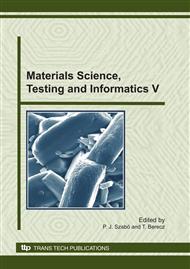p.127
p.135
p.141
p.147
p.153
p.159
p.165
p.171
p.177
Evaluation of Cooling Characteristics of Quenchants by Using Inverse Heat Conduction Methods and Property Prediction
Abstract:
A sequential numerical method for characterization of hardening performance of quenchants applied for steel quenching is outlined here. This novel method is based on the specific processing of measured time–temperature samples performed as a result of cooling curve tests. The heat transfer coefficient, as a function of surface temperature, characterises the heat transfer during cooling and is calculated using an iterative inverse algorithm. The heat transfer coefficient is used for calculation of the microstructural constituents and the hardness profile of cylindrical samples of arbitrary diameters. The hardening performance of the media is evaluated by the estimated hardness of the specimen obtained by heat treatment.
Info:
Periodical:
Pages:
153-158
Citation:
Online since:
September 2010
Authors:
Price:
Сopyright:
© 2010 Trans Tech Publications Ltd. All Rights Reserved
Share:
Citation:


